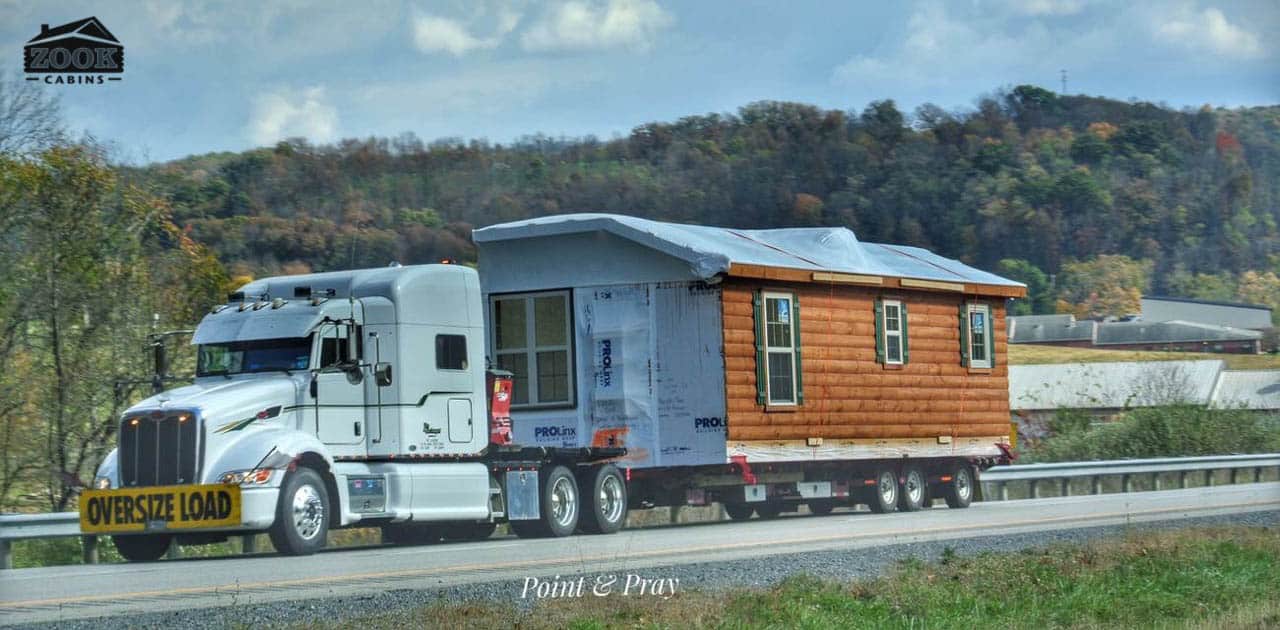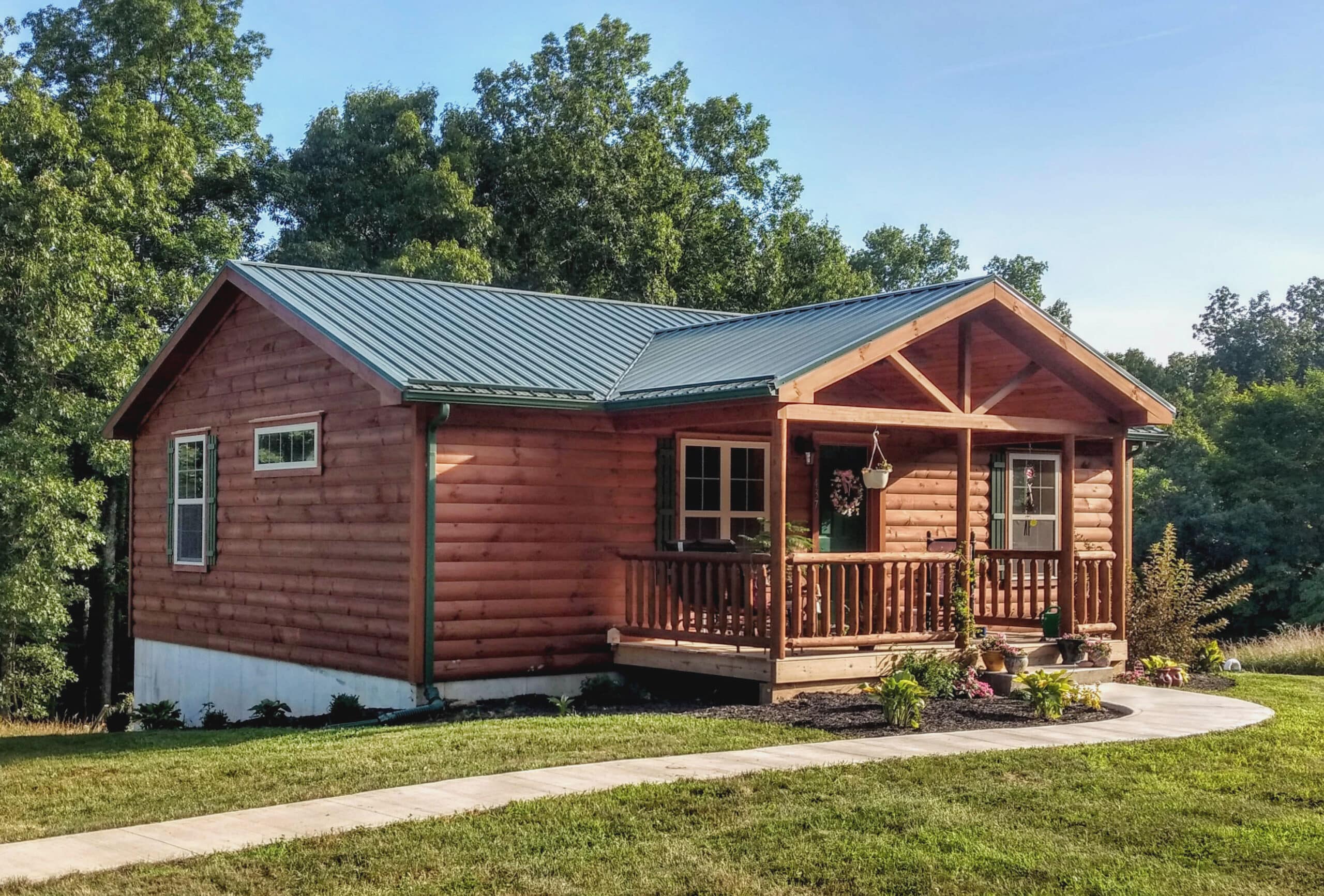By: Lucille Rosetti
If you’re experiencing acceptance and are ready to move on after the loss of a loved one, you may want to look into downsizing your home. Visit Zook Cabins to explore your options.
If you’ve recently lost a loved one, you may still be deep in your season of grief. Everyone grieves differently, and there is no set timeline for cycling through the stages of grief and recovering from a loss. If you are experiencing acceptance and ready to embark upon a new adventure, downsizing your home and getting a fresh start may be exactly what you need.
Benefits Of Moving

Relocating and moving to a new home has many psychological benefits. After a loss, you can benefit from simplifying your life and setting new expectations. Your current home carries many memories of your lost loved one, and this can make it difficult to move on after the loss. A new home is a blank slate for new memories and new adventures. You may also wish to downsize, especially if you’ve lost a supplemental income. This is another benefit of downsizing, moving into a smaller home can also help you reduce your belongings and clutter, in addition to saving money.
Pack Up Your Home

When you’ve made the decision to move out of your current home and venture on to a fresh start, you need to get your home ready to sell. One of the first steps of moving house is to declutter your home. Part of this process will involve going through and sorting your loved one’s belongings, and this is likely to be a difficult process. Psychology Today explains that there is no one way to do this, and everyone will have a different experience. Whether you decide to keep certain things, give away mementos, or get rid of most everything, do whatever feels best to you in the time you need. Decluttering your home to sell does require that you clear out your house, but you can choose to box things out of sight if you are not ready to part with certain items.
Determine Where You Want To Go

The next downsizing home tip is figuring out where you want to go next. There are countless options for you to choose for your fresh start while moving on from the loss of a loved one. If you have always dreamed of living near the ocean, go find a beautiful beach house. If you are ready to breathe in the fresh mountain air surrounded by breathtaking forests, go find a peaceful cabin nestled in the trees. You can even contact a company like Zook Cabins to help you design and build your dream cabin from the ground up. This could be your next home to create new memories with your family, potentially leaving them a beautiful legacy in the future when you are gone.
Take Advantage Of Opportunity To Life Plan
This is also a perfect opportunity for you to do some life planning of your own. Having just gone through recovering from a loss, you have firsthand experience with the challenges of burial and funeral decisions. Funerals cost a considerable amount of money, and you can take the burden off your loved ones by having a plan in place. You may want to consider purchasing burial insurance to cover the costs of your funeral arrangements, in addition to any other debt you may have.
Providing the finances and planning the details of your burial and funeral will be a great relief to your loved ones, who can then turn their focus to recovering from their loss.
Though losing a loved one is hard, there is also an opportunity for great experiences to be had in the future. Give yourself as much time as you need to grieve, and don’t feel like you need to rush on starting the next chapter of your life. But when you are ready, follow these tips and you can prepare to embark upon an exciting new adventure.

Risks
Most fixed-term debt contains penalty clauses (known as “call provisions”) that are triggered by an early payment of the loan, either in its entirety or a specified portion. In addition, there are also closing and transaction fees typically associated with refinancing debt. In some cases, these fees may outweigh any savings generated through refinancing the loan itself. Typically, one only rationally considers refinancing if the potential for a substantial cost savings exists, or if there is a need to extend the loan due to weak cash flow or other non-recurring commitments. In addition, some refinanced loans, while having lower initial payments, may result in larger total interest costs over the life of the loan, or expose the borrower to greater risks than the existing loan, depending on the type of loan used to refinance the existing debt. Calculating the up-front, ongoing and potentially variable costs of refinancing is an important part of the decision on whether or not to refinance.

#2: Zook Cabins Helpful Hint
Any time you are looking to secure a loan, the lender will want to check you out by pulling your credit. Be careful how often you allow this to happen, as each time someone runs your credit it shows negatively on your rating. Allowing multiple credit checks can actually lower your credit score. Find a quality lender who offers rates you are comfortable with and can refer you to satisfied customers before letting them look into your credit.
Points
Refinancing lenders often require an upfront payment of a certain percentage of the total loan amount as part of the process of refinancing debt. Typically, this amount is expressed in “points” (also sometimes called “premiums”), with each “point” being equivalent to 1% of the total loan amount. Therefore, if the refinance option selected involves paying three points, then the borrower will need to pay 3% of the total loan amount upfront. Most refinancing lenders offer a variety of combinations of points and interest rates. Paying more points typically allows one to get a lower interest rate than one would be capable of getting if one paid fewer or no points. Alternately, some lenders will offer to finance parts of the loan themselves, thus generating so-called “negative points” (also called discounts).
The decision of whether or not to pay points and how many points to pay, should be taken into consideration of the fact that with points, one tends to trade a higher upfront cost in exchange for a lower monthly premium later on. Points can be paid out of the cash saved by refinancing the loan in the first place.
Types
Borrowers with this type of refinancing typically pay few upfront fees to get the new mortgage loan. In fact, as long as the prevailing market rate is lower than your existing rate by 1.5 percentage point or more, it is financially beneficial to refinance because there is little or no cost in doing so. However, what most lenders fail to disclose is that the money you save upfront is being collected on the back through what’s called yield spread premium (YSP). Yield spread premiums are the cash that a mortgage company receives for steering a borrower into a home loan with a higher interest rate. The latter will even eventually lead to borrower’s overpaying.
Cash-Out
This type of refinance may not help lower the monthly payment or shorten mortgage periods. It can be used for home improvement, credit card and other debt consolidation if the borrower qualifies with their current home equity. They can refinance with a loan amount larger than their current mortgage and keep the cash difference.
Things to Consider When You Borrow Money
Shop for the best options for financing a cabin– The main thing to consider in a loan is the interest rate. Don’t be afraid to tell the lender you think he can do better, especially if the quotes are close.
Consolidate your loan- it is easier to manage one bill and you will lock in at a lower rate.
Use Equity – your home equity is actually your money and sometimes it pays to use it.
Utilize your line of credit to purchase your log cabin – If you don’t own, or don’t want to use your equity you can consider using your line of credit.
Check the Fine Print – Make sure you read all the details. Pay special attention to “default” and “early repayment”.
Avoid Payday loans – Companies that will give you cash without a credit check will charge outrageous interest rates and should be avoided at all costs.
Maximize your credit score before you borrow – The price you pay for a loan will depend on your credit score. Check what your credit score is and see what you can do to improve it.
Sharing a Cabin
Using the figures from the log cabin financing page and a loan taken at 9% here is how the cost would break down for a log cabin with multiple investors.
Monthly Payment
- $15,000 for 3 yrs $15,000 for 5 yrs $30,000 for 3 yrs $30,000 for 5 yrs $60,000 for 3 yrs $60,000 for 5 yrs
- for 1 investor $477 $311 $954 $622 $1,908 $1,244
- for 2 investors (per inv) $239 $156 $477 $311 $954 $622
- for 3 investors (per inv) $159 $104 $318 $208 $636 $415
- for 4 investors (per inv) $120 $78 $239 $156 $477 $311
Take out a Mortgage on The Property
A mortgage is the pledging of a property to a lender as a security for a mortgage loan. While a mortgage in itself is not a debt, it is evidence of a debt. It is a transfer of an interest in land, from the owner to the mortgage lender, on the condition that this interest will be returned to the owner of the real estate when the terms of the mortgage have been satisfied or performed. In other words, the mortgage is a security for the loan that the lender makes to the borrower.
The term comes from the Old French “dead pledge,” apparently meaning that the pledge ends (dies) either when the obligation is fulfilled or the property is taken through foreclosure.[1]
In most jurisdictions, mortgages are strongly associated with loans secured on real estate rather than other property (such as ships) and in some jurisdictions only land may be mortgaged. Arranging a mortgage is seen as the standard method by which individuals and businesses can purchase residential and commercial real estate without the need to pay the full value immediately.
The measurement of a mortgage with regards to cost to the borrower can be measured by Annual Percentage Rate (APR) or many other formulas for true cost such as Lender Police Effective Annual Rate (LPEAR).
Mortgages can come at various rates and lengths. Be sure to compare all your options before locking into anything and make sure that you read all the fine print. Find a lender you trust and explain what you are trying to do and listen for suggestions they have for the best way to go about it. Make sure that you take the time to shop around and talk to different lenders, to secure the best deal for yourself.

#3: Zook Cabins Helpful Hint
Make sure that you see your credit report for yourself and don’t just take a lenders word for it.
How to Borrow Money from a Friend or Relative
(From “6 tips on borrowing from relatives” by Jennie L. Phipps)
When people find themselves in a money crunch, a natural reaction is to turn to family for help. Parents, grandparents and siblings often are happy to lend a financial hand via a loan. But unless handled carefully, family members — not just the relative advancing the cash, but others — will be resentful.
“There’s no such thing as a family loan without emotional ties,” warns Azriela Jaffe, entrepreneur and author. “If you don’t understand that from the beginning, it will take you by surprise.”
Jaffe says borrowing money from parents, the most-common scenario, can put you back in the same place you were when living under their roof. “Mom and Dad are paying the bills and they feel entitled to tell you what to do. All of a sudden you are 13 again and rebelling.”
Faced with the need to rely on some all-in-the-family money, how do you minimize the potential for resentment and destructive situations? Here’s some advice from people who have been there:
Know from whom you borrow
Houston bankruptcy lawyer John Ventura says before you seek a loan, analyze your relationship with the lender. Ask yourself, “If I lose the money, what will be the outcome?” Relatives for whom money is an obvious emotional issue or those who really can’t afford to lose anything are not good lending candidates, he says. Moreover, you put people in a tough spot when they have to turn you down, creating hurt feelings all around. When you ask, be prepared to handle a refusal graciously.
Seek a co-signer
If the bank will accept a parent or relative’s signature on the note as a guarantee, go that route. Tom Gillis, Houston lawyer and CPA, put up bonds as collateral and signed his son’s notes twice when the younger man opened a heavy equipment manufacturing business. “It’s much more businesslike,” says Gillis. “The bank drew up all papers. All I had to do was sign my name.” The good news is that eight years after the first loan was made, Gillis’ son brought over a bottle of champagne and the paid-off notes.
Put everything in writing
It may be sufficient in a very simple transaction to write a letter that specifies the terms of the agreement. But the best way may be to get a lawyer involved, particularly if it is a significant sum of money. That protects both sides. “Give your family the same respect that you’d give a professional lender,” says Jaffe, author of the Complete Idiot’s Guide to Beating Debt. “In return, that increases the chances they’ll treat you with respect.”
Know the tax laws
If the loan is for less than $10,000, it will probably escape the IRS’ attention. But if your family loan is for a significant amount, make sure you understand the tax and other legal consequences, particularly if the lender dies before the loan is paid off. The IRS considers loans that are forgiven as taxable income. James Walsh, an insurance consultant and author of Family Money, suggests insuring the lender’s life for the amount of the loan as one way to guarantee repayment and avoid tax problems.
Give lenders something tangible
Specific collateral for either co-signers or lenders will ease concerns and ensure that they don’t lose everything if things don’t go well. Bankruptcy attorney Ventura says that if you are forced to file bankruptcy, provided you’ve structured the agreement properly, your lender will have a lien on your house or your car. That will put them at the top of the list of creditors. “You and your relative will get peace of mind. And if you have a close enough relationship and the item is repossessed, chances are it will just be given back to you,” Ventura says.
Tell the world your business
You may think the financial deal is just between you and dad, but family secrets are hard to keep. Siblings, in particular, are likely to be concerned about loans from parents. Gerald LeVan, managing director of LeVan Co., family business consultants based in North Carolina, recommends telling other close relatives how much you’re borrowing, why you’re doing it and then keeping them posted about how your financial affairs are going. “It cuts down on the feelings of favoritism and jealousy,” he says.
How to Clean Up your Credit Record
- Pay all bills on time.
- Pay off as much debt as possible.
- Try not to close too many credit card accounts.
- Pay off outstanding loans as soon as possible.
- Change your personal spending habits.
- Paying by Check
Some will ask What is a Cashier’s Check
The cashier’s check is known by many synonyms. It can be called a bank check, a teller’s check, a treasurer’s check, or an official check to name just a few. It is different than the type of check you would write from a personal bank account and usually considered more acceptable for certain transactions, because it provides in most cases, a guarantee of payment to the receiver of the check.
What makes the cashier’s check unique is that funds are not drawn from your personal account. As most people know, funds can shift in a personal account on a daily basis. Even if you can prove to someone that you have money in your account to cover a check, that might only be true for a moment or two. Checks are cleared in the order they are received and if you have other outstanding checks, the value of your checking account will shift when these checks do clear.
In order to get a cashier’s check, you withdraw funds from your personal account, or you have cash available. You then pay these funds to the bank that creates the bank check; this is often your own bank. Funds from the check are then drawn on the bank and not on your personal account. Thus, this form of check is considered secure, especially when issued by a reputable bank. There is very little possibility of a legitimate cashier’s check bouncing, since the bank is the payer of the check.
If a person fraudulently writes a check to cover the cashier’s check, the bank might try not to cash the check. In most cases, this is not an issue, since most people use their own banks to get cashier’s checks and the bank has immediate access to information about the person’s bank account. The bank won’t accept a check from a person to create a bank check if they know there are not sufficient funds to cover the check.
Some institutions will require a cashier’s check as a secure form of payment. For instance, you may need to get one for deposits on or purchases of automobiles, for deposits or first month’s rent for a newly rented apartment or for a down payment on a house. This really depends upon the institution or business. Some people find the process of obtaining these checks tiresome and in most cases, there is a fee attached to getting a check of this type. This fee may be a percentage of the total check or a flat fee and this again depends upon the issuing bank and your relationship to the bank, (such as your being a customer of the bank).
The rise in Internet fraud has prompted many to fall victim to phony or fake check scams. A “private” individual emails you regarding a check they wish you to deposit and in exchange you will transfer funds to them from your own account. These checks are often cashier’s checks and they can look very real.
It’s a good idea first off, to never deposit a check from someone you didn’t know yesterday and who is claiming to be from a foreign country or some such, especially when these folks contact you via email. Second, if you do accept cashier’s checks, be sure it is issued from a bank you know and verify independently of the address or contact number on the check, that the bank actually exists and is legitimate. If it is a bank you’re familiar with, verify with the bank to be certain the check isn’t a phony. This is especially helpful when it comes to private transactions between individuals, such as someone paying you with a cashier’s check to purchase something from you.
